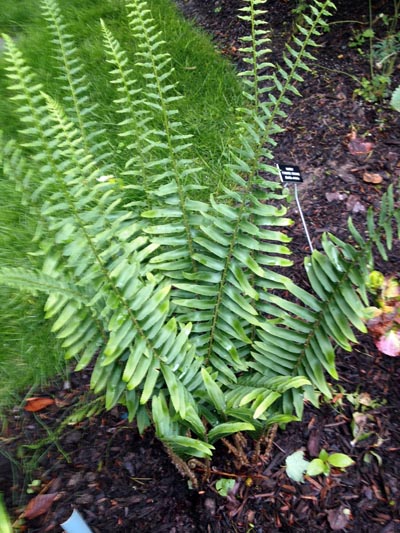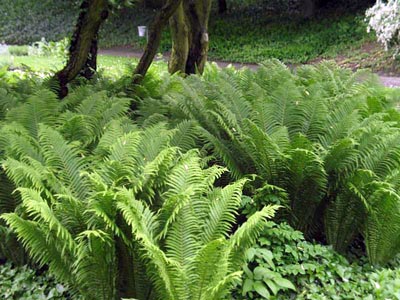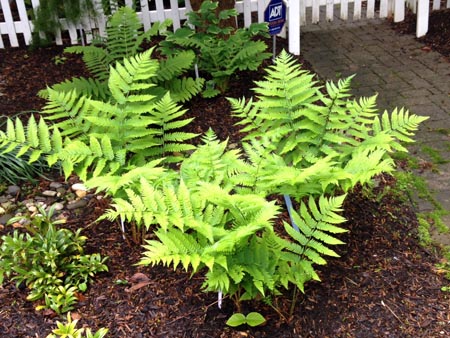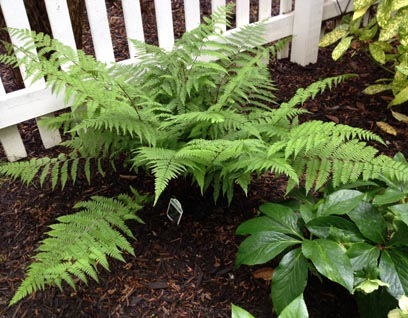Carefree Ferns for Your Landscape
By Gil Medeiros, Fairfax Master Gardener
I am an unabashed fan of ferns in the garden, a friend of the fronds, so to speak. The new curled fiddleheads emerging in spring, the graceful arching fronds in summer, and sometimes even the change of color in the fall bring life to a shade or woodland garden. Ferns are also relatively free of insect and disease problems. Deer and rabbits generally leave them alone. Rabbits are difficult to restrain on my property, so I particularly like it when hungry Bugs Bunny passes by the ferns.
Over the past five years, I have tried 16 different fern species in seven different genera. I didn’t intend to build a fern collection; these were mostly impulse buys out of curiosity. I have bought them in various sizes from both garden centers and catalogs.
This is not a scientific study with controlled variables. I have planted ferns in shady and moist (but not well drained) garden beds in my yard. Some planting locations are wetter than others. Some are shadier than others. None of the soil is improved; no compost, no fertilizer. It is basically mulch over familiar Northern Virginia clay, a good test of the adaptability of ferns.
I don’t provide any care for the ferns except to trim old foliage after they send new growth in the spring. They really have to make it on their own. The fact that I have had good success with 11 of the 16 species I have planted stands as testament to the ease of growing ferns.

Christmas Fern
There are at least three legends as to the origin of the name; two of them have to do with the fact that this fern is still green at Christmas; the other is related to the subtle bend in the pinnae (leaflets). If you look at them a certain way, they resemble tiny Christmas stockings.
The Christmas Fern is native. It is also evergreen, but ferns are not woody plants. A major snowfall like the Blizzard of 2016 will squash the Christmas Fern flat to the ground where it will stay — green — until it pushes up new fiddleheads in the spring. Early in my fern collecting days, I favored plants that were listed as evergreen. However, I have learned that an evergreen fern in Northern Virginia provides interest only through the rare snowless winter.
The Christmas Fern is a trouble-free plant, a slow grower that forms clumps that expand only incrementally from year to year. It is tolerant of the dry and wet soils of my shade garden. I have planted four of them, and they have all thrived.
The leaflets are not as complex and featherlike as some of the others; it does not stand out among ferns for its physical beauty. However, it still adds grace to the shade garden in places where it is difficult to grow anything else.

Ostrich fern
This is a native and an aggressive spreader. It surprises the gardener by producing new plants on rhizomes several feet from the nearest clump. I started with three ostrich ferns in 2011; now I have about 12, and I routinely transplant far-flung new fiddleheads to areas that I want to see filled.
It is not unusual for the fronds to grow vertically to a height of about 2 1/2 feet before they assume a less upright, more arching stance.
This is a truly beautiful plant with wide feathery fronds until late summer when the vegetative fronds (these contain no spores) take on a tattered appearance. The shorter fertile fronds (these contain spores) remain brown. The late summer appearance is a good reason not to commit your entire shade garden to the ostrich fern. This one dies back in winter but comes back even stronger in the spring.

Three Goldie’s Ferns in the foreground. Two Interrupted Ferns in the background
Plant Goldie and step aside because it doesn’t need any help. I have planted three of them, and they have done well.
This native fern is named for the 19th-century Scottish botanist John Goldie who is credited as the first European to bring samples back from North America. The Dryopteris genera are commonly called “wood ferns.” Indeed, this one is sometimes called the Giant Wood Fern because it can grow to 4 feet tall under ideal conditions. Mine have grown so far to about 2 1/2 feet, but since they are fairly erect, you might want to put this fern toward the back of the planting bed. D. goldiana forms tight clumps that are difficult to divide.

Lady Fern flanked by hellebores
This has the quintessential fern look. It forms a tight clump of delicate fronds. This ancient plant is considered native to three continents: North America, Europe and Asia. The Lady Fern likes drier soil than most; fortunately I planted it in a relatively dry part of my shade garden, and it is thriving. I have only one, but I like to admire it.
Lady Fern is deciduous. It can take more sun than some, but it will need more water.

Japanese Painted Fern
This is the only non-native on my short list of favorite, carefree ferns. I like it because of its exotic silvery foliage that stands out among other ferns. It is deciduous, a slow spreader and relatively small, only growing to a foot or so.
I have three, and they are all thriving in both wet and dry soil.
This must be a popular plant because it is ubiquitous at garden centers. Not only is it easy to find, it is easy to grow.
The best of the rest
Autumn Fern (Dryopteris erythrosora)
An Asian import that is evergreen. I have three, and they have done fine. This fern undergoes an interesting color change from reddish to green to tan from spring through fall.
Cinnamon Fern (Osmunda cinnamomea)
Native to North America and Asia, I have planted two and both are doing fine.
Interrupted Fern (Osmundia claytoniana)
I have planted three, and they are thriving after a slow start. The rounded pinnae (leaflets) give this one a different appearance that stands in subtle contrast to the others.
Dixie Wood Fern (Dryopteris x australis)
This native hybrid is propagated by tissue culture. It has a tall, erect growth habit that really stands out in the garden. I have planted one, and it is thriving after a slow start that is attributable to the fact that it was a small plant (3 ½-inch pot) obtained from an online vendor. It takes a full three years for one of these little UPS-delivered babies to reach mature size.
Southern Shield Fern (Thelypteris kunthii)
Another native, this fern strongly resembles members of the Dryopteris genus, where it has, in fact, been classified over the years. I have one. After rapid growth in the second year, in its third year this erect plant is currently the tallest in my fern collection.
Marginal Wood Fern (Dryopteris marginalis)
I planted two but lost one. The survivor is doing well.
Disappointing
Southern Wood Fern (Dryopteris ludoviciana)
This one has struggled. So far, it has sent up only one frond during its 2 ½ year tenure in my garden. I am somewhat surprised because it is very common woodland plant south of here.
Hay-Scented Fern (Dennstaedtia punctilobula)
This is advertised as an aggressive spreader, the best choice for the gardener who wants to fill an empty area with ferns. It hasn’t done particularly well for me. I have planted four; lost two; a third is surviving but weak, and the fourth is doing ok. Supposedly the crushed fronds smell like freshly cut hay. I have not had enough fronds to verify this.
Tassel Fern (Polystichum polyblepharum)
These are beautiful Asian ferns with glossy foliage. They are evergreen. I have planted six of them because I really like the appearance. Two died during the polar vortex winter of 2013-14. The other four are only limping along. I suspect the ground is too wet for them. They are known to suffer from crown rot in poorly drained soil.
Remote Wood Fern (Dryopteris x remota)
I started with a big healthy plant obtained from a local garden center two years ago. It is just barely surviving.
This one didn’t make it
Wide Leaf Autumn Fern (Dryopteris nipponensis)
I bought a small plant from a mail order vendor three years ago. I transplanted it after one year. It did not survive its second winter in my garden.
There are two takeaway messages from my experience. Success with ferns is almost assured in wet and shady environments even when the soil is clay that is not well drained. My success rate with ferns is only exceeded by my success rate with hellebores, another easy-to-grow shade plant. Both of these exceed by plenty my batting average with other perennials. The second message is to be fearless in sampling different species. You will likely be rewarded with a variety of delightful shapes, textures, colors, and sizes. Give ferns a try.
References
Hardy Ferns, HGIC 1176, Clemson Cooperative Extension, Home and Garden information Centerhttp
Dryopteris goldiana, Plant Finder, Missouri Botanical Garden
Matteuccia struthiopteris, Plant Finder, Missouri Botanical Garden
Polystichum acrostichoides, Plant Finder, Missouri Botanical Garden
Athyrium filix- femina, Plant Finder, Missouri Botanical Garden
Athyrium nipponicum, Plant Finder, Missouri Botanical Garden